Workplace Stress: A Potential Killer
VerifiedAdded on 2023/04/22
|7
|1977
|446
AI Summary
This article discusses the negative health implications of workplace stress. It reviews literature on the correlation between work stress and hypertension, coronary heart disease, cardiovascular diseases, and blood pressure. The article also provides a theoretical perspective on the job demand theory and critical analysis of the impact of work stress on workers' health.
Contribute Materials
Your contribution can guide someone’s learning journey. Share your
documents today.
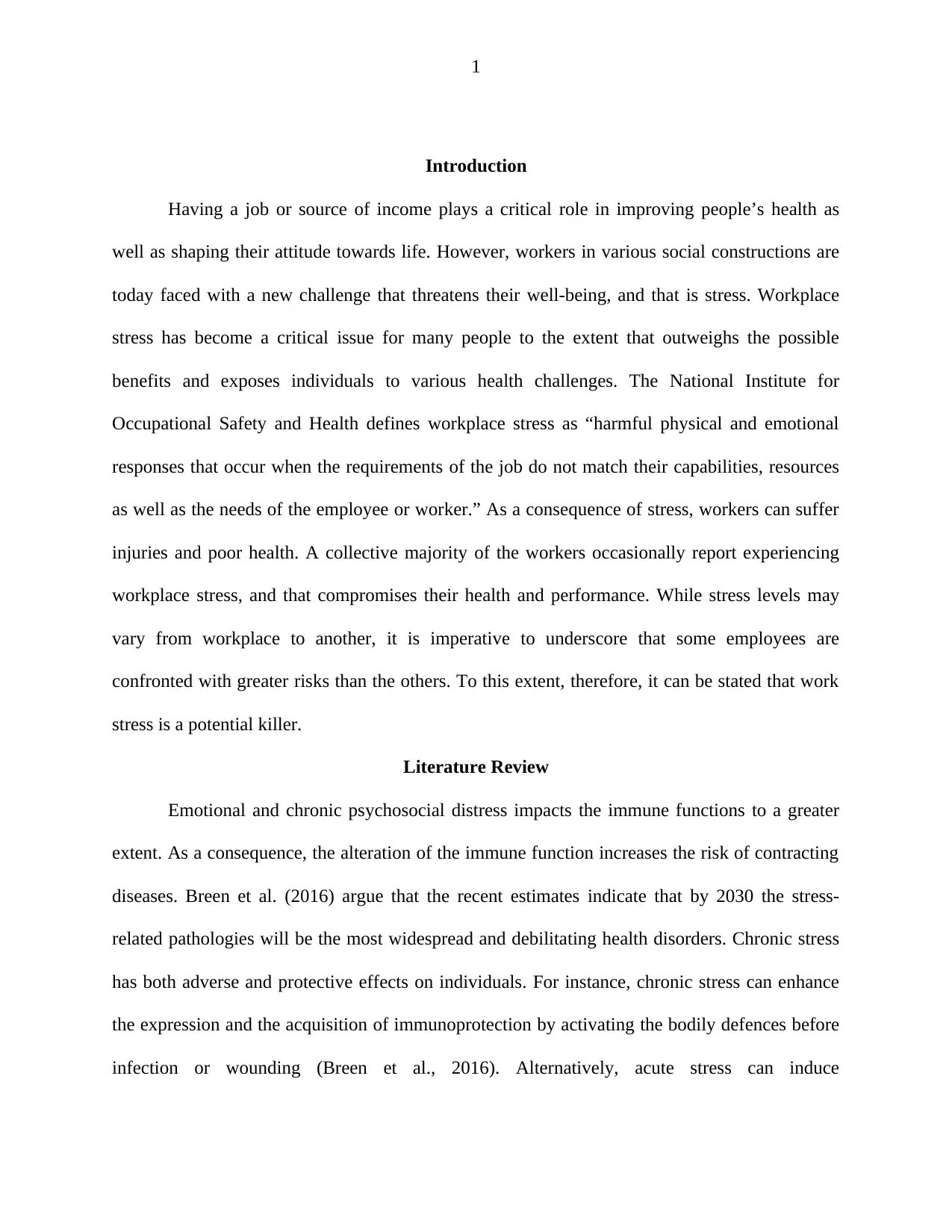
1
Introduction
Having a job or source of income plays a critical role in improving people’s health as
well as shaping their attitude towards life. However, workers in various social constructions are
today faced with a new challenge that threatens their well-being, and that is stress. Workplace
stress has become a critical issue for many people to the extent that outweighs the possible
benefits and exposes individuals to various health challenges. The National Institute for
Occupational Safety and Health defines workplace stress as “harmful physical and emotional
responses that occur when the requirements of the job do not match their capabilities, resources
as well as the needs of the employee or worker.” As a consequence of stress, workers can suffer
injuries and poor health. A collective majority of the workers occasionally report experiencing
workplace stress, and that compromises their health and performance. While stress levels may
vary from workplace to another, it is imperative to underscore that some employees are
confronted with greater risks than the others. To this extent, therefore, it can be stated that work
stress is a potential killer.
Literature Review
Emotional and chronic psychosocial distress impacts the immune functions to a greater
extent. As a consequence, the alteration of the immune function increases the risk of contracting
diseases. Breen et al. (2016) argue that the recent estimates indicate that by 2030 the stress-
related pathologies will be the most widespread and debilitating health disorders. Chronic stress
has both adverse and protective effects on individuals. For instance, chronic stress can enhance
the expression and the acquisition of immunoprotection by activating the bodily defences before
infection or wounding (Breen et al., 2016). Alternatively, acute stress can induce
Introduction
Having a job or source of income plays a critical role in improving people’s health as
well as shaping their attitude towards life. However, workers in various social constructions are
today faced with a new challenge that threatens their well-being, and that is stress. Workplace
stress has become a critical issue for many people to the extent that outweighs the possible
benefits and exposes individuals to various health challenges. The National Institute for
Occupational Safety and Health defines workplace stress as “harmful physical and emotional
responses that occur when the requirements of the job do not match their capabilities, resources
as well as the needs of the employee or worker.” As a consequence of stress, workers can suffer
injuries and poor health. A collective majority of the workers occasionally report experiencing
workplace stress, and that compromises their health and performance. While stress levels may
vary from workplace to another, it is imperative to underscore that some employees are
confronted with greater risks than the others. To this extent, therefore, it can be stated that work
stress is a potential killer.
Literature Review
Emotional and chronic psychosocial distress impacts the immune functions to a greater
extent. As a consequence, the alteration of the immune function increases the risk of contracting
diseases. Breen et al. (2016) argue that the recent estimates indicate that by 2030 the stress-
related pathologies will be the most widespread and debilitating health disorders. Chronic stress
has both adverse and protective effects on individuals. For instance, chronic stress can enhance
the expression and the acquisition of immunoprotection by activating the bodily defences before
infection or wounding (Breen et al., 2016). Alternatively, acute stress can induce
Secure Best Marks with AI Grader
Need help grading? Try our AI Grader for instant feedback on your assignments.
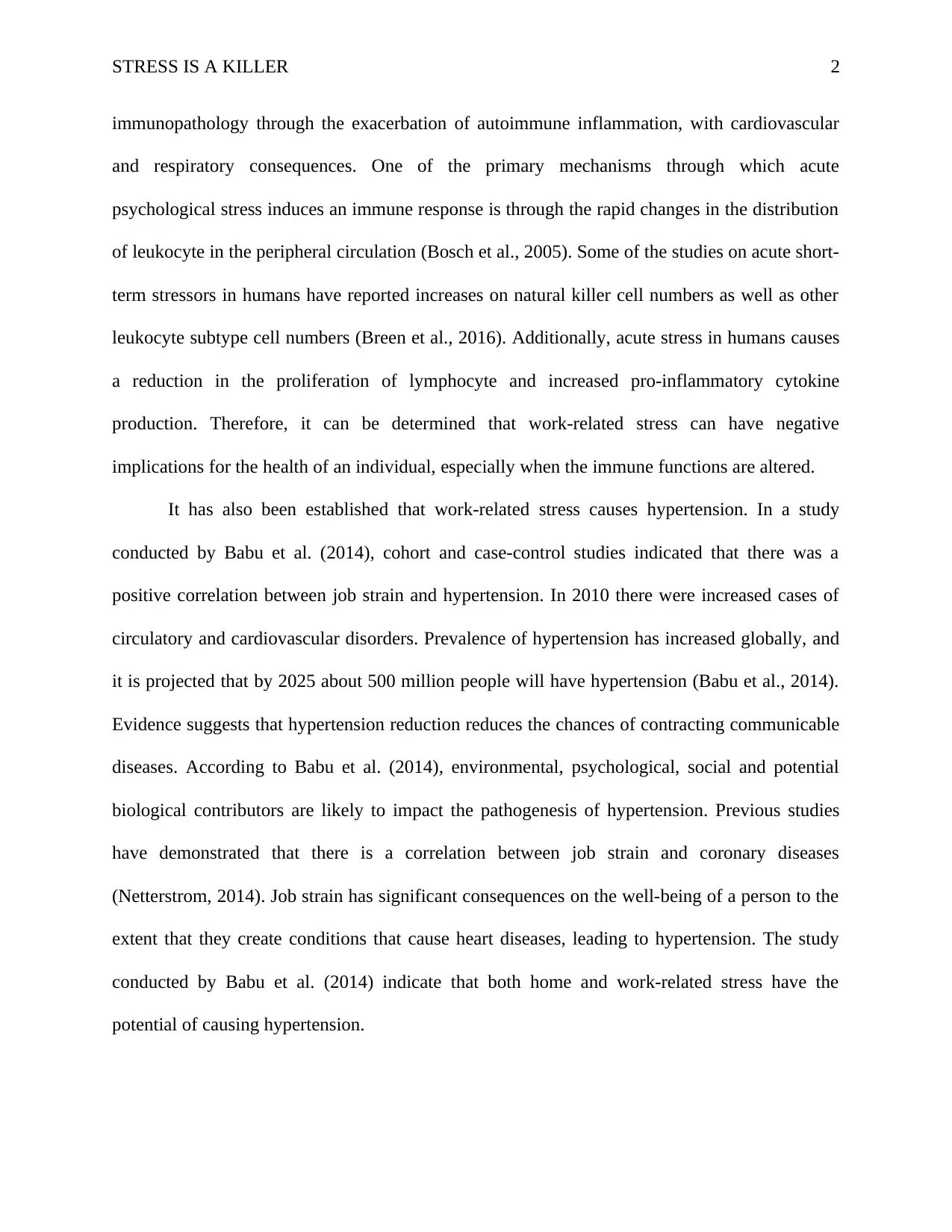
STRESS IS A KILLER 2
immunopathology through the exacerbation of autoimmune inflammation, with cardiovascular
and respiratory consequences. One of the primary mechanisms through which acute
psychological stress induces an immune response is through the rapid changes in the distribution
of leukocyte in the peripheral circulation (Bosch et al., 2005). Some of the studies on acute short-
term stressors in humans have reported increases on natural killer cell numbers as well as other
leukocyte subtype cell numbers (Breen et al., 2016). Additionally, acute stress in humans causes
a reduction in the proliferation of lymphocyte and increased pro-inflammatory cytokine
production. Therefore, it can be determined that work-related stress can have negative
implications for the health of an individual, especially when the immune functions are altered.
It has also been established that work-related stress causes hypertension. In a study
conducted by Babu et al. (2014), cohort and case-control studies indicated that there was a
positive correlation between job strain and hypertension. In 2010 there were increased cases of
circulatory and cardiovascular disorders. Prevalence of hypertension has increased globally, and
it is projected that by 2025 about 500 million people will have hypertension (Babu et al., 2014).
Evidence suggests that hypertension reduction reduces the chances of contracting communicable
diseases. According to Babu et al. (2014), environmental, psychological, social and potential
biological contributors are likely to impact the pathogenesis of hypertension. Previous studies
have demonstrated that there is a correlation between job strain and coronary diseases
(Netterstrom, 2014). Job strain has significant consequences on the well-being of a person to the
extent that they create conditions that cause heart diseases, leading to hypertension. The study
conducted by Babu et al. (2014) indicate that both home and work-related stress have the
potential of causing hypertension.
immunopathology through the exacerbation of autoimmune inflammation, with cardiovascular
and respiratory consequences. One of the primary mechanisms through which acute
psychological stress induces an immune response is through the rapid changes in the distribution
of leukocyte in the peripheral circulation (Bosch et al., 2005). Some of the studies on acute short-
term stressors in humans have reported increases on natural killer cell numbers as well as other
leukocyte subtype cell numbers (Breen et al., 2016). Additionally, acute stress in humans causes
a reduction in the proliferation of lymphocyte and increased pro-inflammatory cytokine
production. Therefore, it can be determined that work-related stress can have negative
implications for the health of an individual, especially when the immune functions are altered.
It has also been established that work-related stress causes hypertension. In a study
conducted by Babu et al. (2014), cohort and case-control studies indicated that there was a
positive correlation between job strain and hypertension. In 2010 there were increased cases of
circulatory and cardiovascular disorders. Prevalence of hypertension has increased globally, and
it is projected that by 2025 about 500 million people will have hypertension (Babu et al., 2014).
Evidence suggests that hypertension reduction reduces the chances of contracting communicable
diseases. According to Babu et al. (2014), environmental, psychological, social and potential
biological contributors are likely to impact the pathogenesis of hypertension. Previous studies
have demonstrated that there is a correlation between job strain and coronary diseases
(Netterstrom, 2014). Job strain has significant consequences on the well-being of a person to the
extent that they create conditions that cause heart diseases, leading to hypertension. The study
conducted by Babu et al. (2014) indicate that both home and work-related stress have the
potential of causing hypertension.
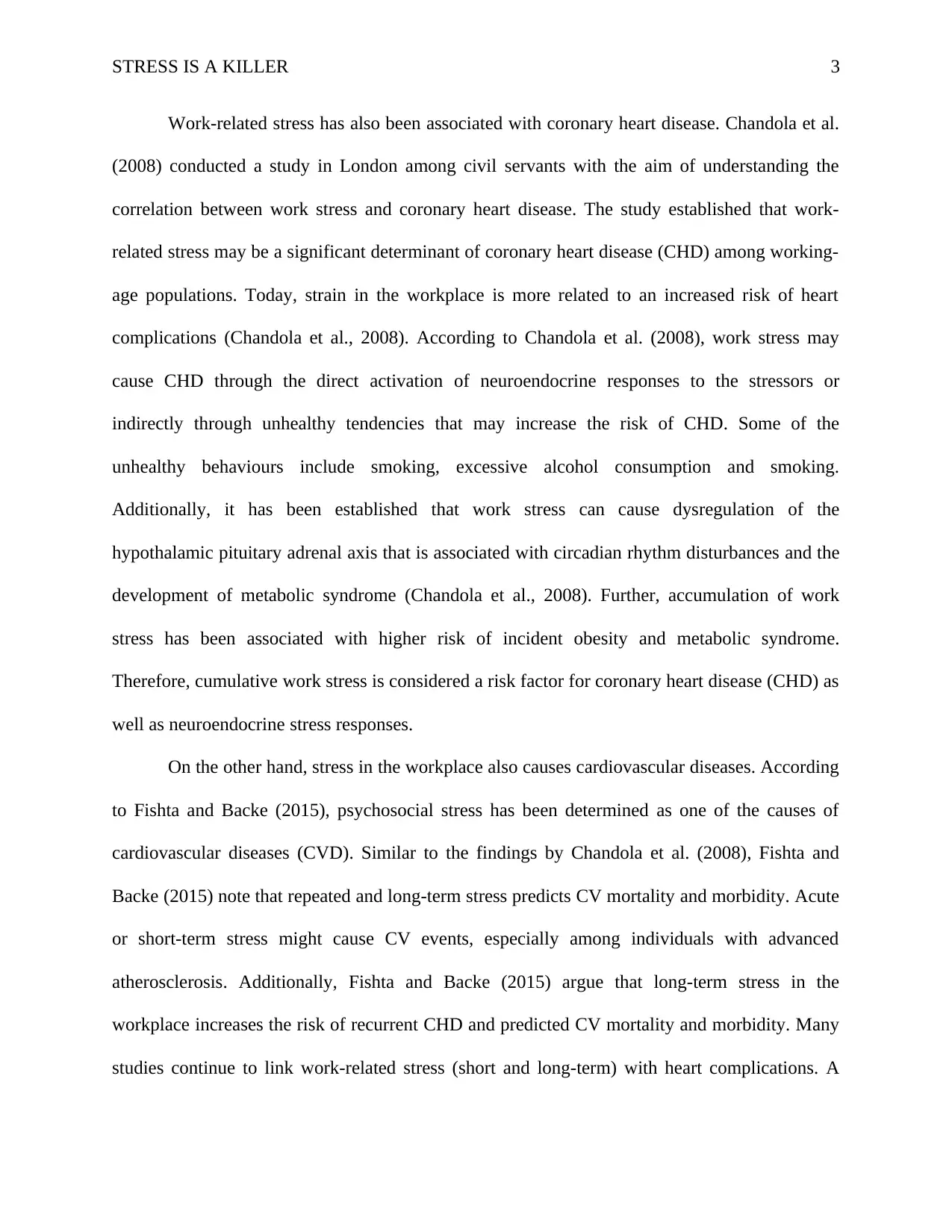
STRESS IS A KILLER 3
Work-related stress has also been associated with coronary heart disease. Chandola et al.
(2008) conducted a study in London among civil servants with the aim of understanding the
correlation between work stress and coronary heart disease. The study established that work-
related stress may be a significant determinant of coronary heart disease (CHD) among working-
age populations. Today, strain in the workplace is more related to an increased risk of heart
complications (Chandola et al., 2008). According to Chandola et al. (2008), work stress may
cause CHD through the direct activation of neuroendocrine responses to the stressors or
indirectly through unhealthy tendencies that may increase the risk of CHD. Some of the
unhealthy behaviours include smoking, excessive alcohol consumption and smoking.
Additionally, it has been established that work stress can cause dysregulation of the
hypothalamic pituitary adrenal axis that is associated with circadian rhythm disturbances and the
development of metabolic syndrome (Chandola et al., 2008). Further, accumulation of work
stress has been associated with higher risk of incident obesity and metabolic syndrome.
Therefore, cumulative work stress is considered a risk factor for coronary heart disease (CHD) as
well as neuroendocrine stress responses.
On the other hand, stress in the workplace also causes cardiovascular diseases. According
to Fishta and Backe (2015), psychosocial stress has been determined as one of the causes of
cardiovascular diseases (CVD). Similar to the findings by Chandola et al. (2008), Fishta and
Backe (2015) note that repeated and long-term stress predicts CV mortality and morbidity. Acute
or short-term stress might cause CV events, especially among individuals with advanced
atherosclerosis. Additionally, Fishta and Backe (2015) argue that long-term stress in the
workplace increases the risk of recurrent CHD and predicted CV mortality and morbidity. Many
studies continue to link work-related stress (short and long-term) with heart complications. A
Work-related stress has also been associated with coronary heart disease. Chandola et al.
(2008) conducted a study in London among civil servants with the aim of understanding the
correlation between work stress and coronary heart disease. The study established that work-
related stress may be a significant determinant of coronary heart disease (CHD) among working-
age populations. Today, strain in the workplace is more related to an increased risk of heart
complications (Chandola et al., 2008). According to Chandola et al. (2008), work stress may
cause CHD through the direct activation of neuroendocrine responses to the stressors or
indirectly through unhealthy tendencies that may increase the risk of CHD. Some of the
unhealthy behaviours include smoking, excessive alcohol consumption and smoking.
Additionally, it has been established that work stress can cause dysregulation of the
hypothalamic pituitary adrenal axis that is associated with circadian rhythm disturbances and the
development of metabolic syndrome (Chandola et al., 2008). Further, accumulation of work
stress has been associated with higher risk of incident obesity and metabolic syndrome.
Therefore, cumulative work stress is considered a risk factor for coronary heart disease (CHD) as
well as neuroendocrine stress responses.
On the other hand, stress in the workplace also causes cardiovascular diseases. According
to Fishta and Backe (2015), psychosocial stress has been determined as one of the causes of
cardiovascular diseases (CVD). Similar to the findings by Chandola et al. (2008), Fishta and
Backe (2015) note that repeated and long-term stress predicts CV mortality and morbidity. Acute
or short-term stress might cause CV events, especially among individuals with advanced
atherosclerosis. Additionally, Fishta and Backe (2015) argue that long-term stress in the
workplace increases the risk of recurrent CHD and predicted CV mortality and morbidity. Many
studies continue to link work-related stress (short and long-term) with heart complications. A
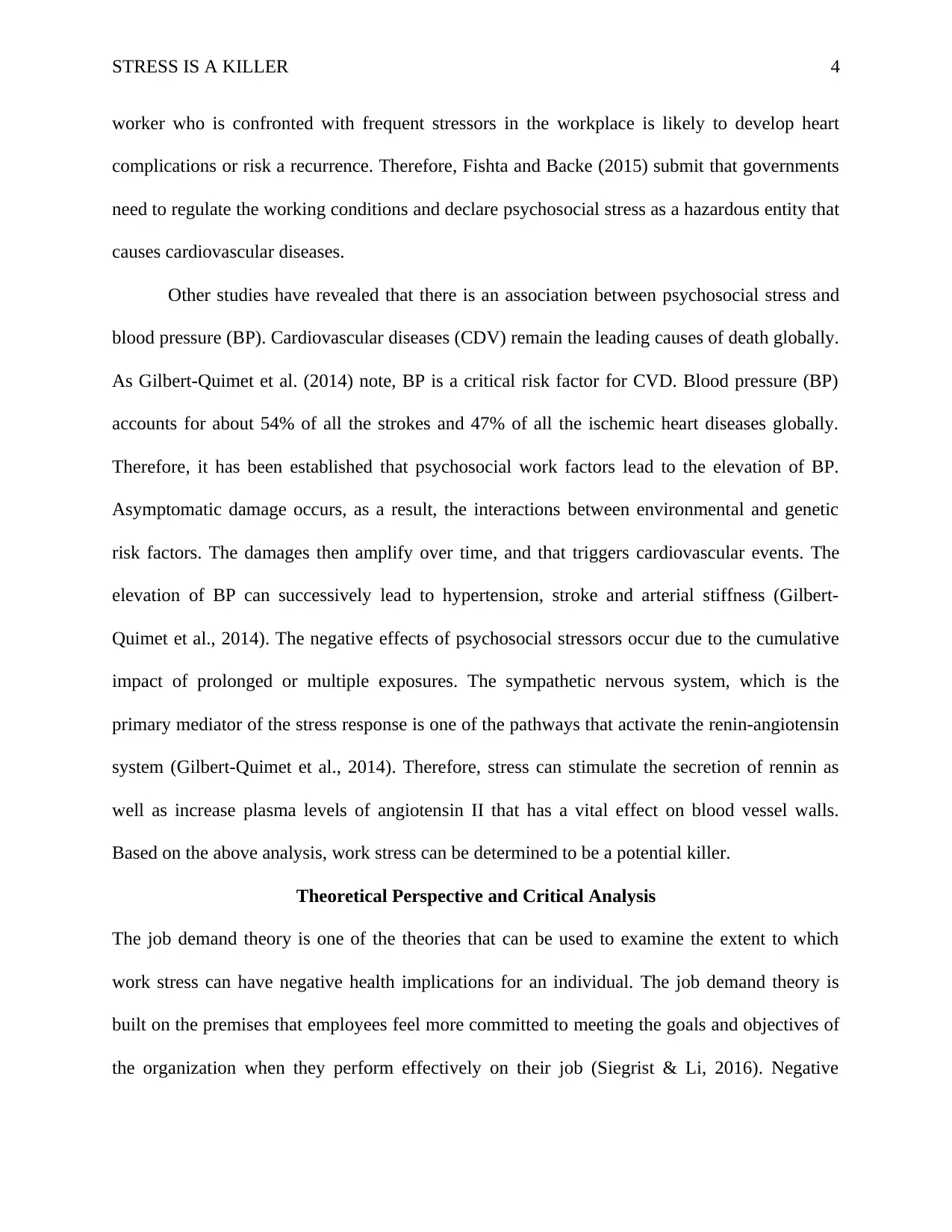
STRESS IS A KILLER 4
worker who is confronted with frequent stressors in the workplace is likely to develop heart
complications or risk a recurrence. Therefore, Fishta and Backe (2015) submit that governments
need to regulate the working conditions and declare psychosocial stress as a hazardous entity that
causes cardiovascular diseases.
Other studies have revealed that there is an association between psychosocial stress and
blood pressure (BP). Cardiovascular diseases (CDV) remain the leading causes of death globally.
As Gilbert-Quimet et al. (2014) note, BP is a critical risk factor for CVD. Blood pressure (BP)
accounts for about 54% of all the strokes and 47% of all the ischemic heart diseases globally.
Therefore, it has been established that psychosocial work factors lead to the elevation of BP.
Asymptomatic damage occurs, as a result, the interactions between environmental and genetic
risk factors. The damages then amplify over time, and that triggers cardiovascular events. The
elevation of BP can successively lead to hypertension, stroke and arterial stiffness (Gilbert-
Quimet et al., 2014). The negative effects of psychosocial stressors occur due to the cumulative
impact of prolonged or multiple exposures. The sympathetic nervous system, which is the
primary mediator of the stress response is one of the pathways that activate the renin-angiotensin
system (Gilbert-Quimet et al., 2014). Therefore, stress can stimulate the secretion of rennin as
well as increase plasma levels of angiotensin II that has a vital effect on blood vessel walls.
Based on the above analysis, work stress can be determined to be a potential killer.
Theoretical Perspective and Critical Analysis
The job demand theory is one of the theories that can be used to examine the extent to which
work stress can have negative health implications for an individual. The job demand theory is
built on the premises that employees feel more committed to meeting the goals and objectives of
the organization when they perform effectively on their job (Siegrist & Li, 2016). Negative
worker who is confronted with frequent stressors in the workplace is likely to develop heart
complications or risk a recurrence. Therefore, Fishta and Backe (2015) submit that governments
need to regulate the working conditions and declare psychosocial stress as a hazardous entity that
causes cardiovascular diseases.
Other studies have revealed that there is an association between psychosocial stress and
blood pressure (BP). Cardiovascular diseases (CDV) remain the leading causes of death globally.
As Gilbert-Quimet et al. (2014) note, BP is a critical risk factor for CVD. Blood pressure (BP)
accounts for about 54% of all the strokes and 47% of all the ischemic heart diseases globally.
Therefore, it has been established that psychosocial work factors lead to the elevation of BP.
Asymptomatic damage occurs, as a result, the interactions between environmental and genetic
risk factors. The damages then amplify over time, and that triggers cardiovascular events. The
elevation of BP can successively lead to hypertension, stroke and arterial stiffness (Gilbert-
Quimet et al., 2014). The negative effects of psychosocial stressors occur due to the cumulative
impact of prolonged or multiple exposures. The sympathetic nervous system, which is the
primary mediator of the stress response is one of the pathways that activate the renin-angiotensin
system (Gilbert-Quimet et al., 2014). Therefore, stress can stimulate the secretion of rennin as
well as increase plasma levels of angiotensin II that has a vital effect on blood vessel walls.
Based on the above analysis, work stress can be determined to be a potential killer.
Theoretical Perspective and Critical Analysis
The job demand theory is one of the theories that can be used to examine the extent to which
work stress can have negative health implications for an individual. The job demand theory is
built on the premises that employees feel more committed to meeting the goals and objectives of
the organization when they perform effectively on their job (Siegrist & Li, 2016). Negative
Secure Best Marks with AI Grader
Need help grading? Try our AI Grader for instant feedback on your assignments.
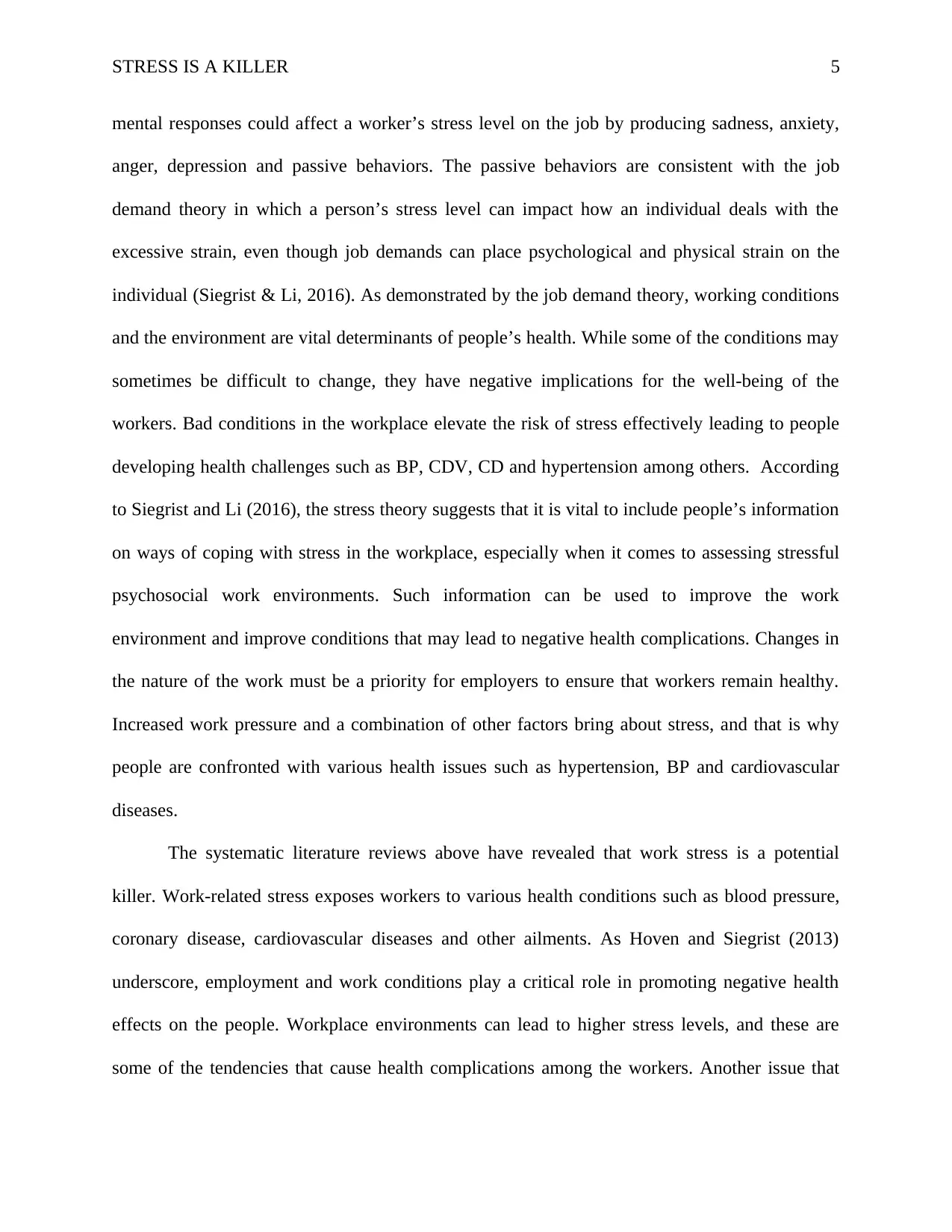
STRESS IS A KILLER 5
mental responses could affect a worker’s stress level on the job by producing sadness, anxiety,
anger, depression and passive behaviors. The passive behaviors are consistent with the job
demand theory in which a person’s stress level can impact how an individual deals with the
excessive strain, even though job demands can place psychological and physical strain on the
individual (Siegrist & Li, 2016). As demonstrated by the job demand theory, working conditions
and the environment are vital determinants of people’s health. While some of the conditions may
sometimes be difficult to change, they have negative implications for the well-being of the
workers. Bad conditions in the workplace elevate the risk of stress effectively leading to people
developing health challenges such as BP, CDV, CD and hypertension among others. According
to Siegrist and Li (2016), the stress theory suggests that it is vital to include people’s information
on ways of coping with stress in the workplace, especially when it comes to assessing stressful
psychosocial work environments. Such information can be used to improve the work
environment and improve conditions that may lead to negative health complications. Changes in
the nature of the work must be a priority for employers to ensure that workers remain healthy.
Increased work pressure and a combination of other factors bring about stress, and that is why
people are confronted with various health issues such as hypertension, BP and cardiovascular
diseases.
The systematic literature reviews above have revealed that work stress is a potential
killer. Work-related stress exposes workers to various health conditions such as blood pressure,
coronary disease, cardiovascular diseases and other ailments. As Hoven and Siegrist (2013)
underscore, employment and work conditions play a critical role in promoting negative health
effects on the people. Workplace environments can lead to higher stress levels, and these are
some of the tendencies that cause health complications among the workers. Another issue that
mental responses could affect a worker’s stress level on the job by producing sadness, anxiety,
anger, depression and passive behaviors. The passive behaviors are consistent with the job
demand theory in which a person’s stress level can impact how an individual deals with the
excessive strain, even though job demands can place psychological and physical strain on the
individual (Siegrist & Li, 2016). As demonstrated by the job demand theory, working conditions
and the environment are vital determinants of people’s health. While some of the conditions may
sometimes be difficult to change, they have negative implications for the well-being of the
workers. Bad conditions in the workplace elevate the risk of stress effectively leading to people
developing health challenges such as BP, CDV, CD and hypertension among others. According
to Siegrist and Li (2016), the stress theory suggests that it is vital to include people’s information
on ways of coping with stress in the workplace, especially when it comes to assessing stressful
psychosocial work environments. Such information can be used to improve the work
environment and improve conditions that may lead to negative health complications. Changes in
the nature of the work must be a priority for employers to ensure that workers remain healthy.
Increased work pressure and a combination of other factors bring about stress, and that is why
people are confronted with various health issues such as hypertension, BP and cardiovascular
diseases.
The systematic literature reviews above have revealed that work stress is a potential
killer. Work-related stress exposes workers to various health conditions such as blood pressure,
coronary disease, cardiovascular diseases and other ailments. As Hoven and Siegrist (2013)
underscore, employment and work conditions play a critical role in promoting negative health
effects on the people. Workplace environments can lead to higher stress levels, and these are
some of the tendencies that cause health complications among the workers. Another issue that
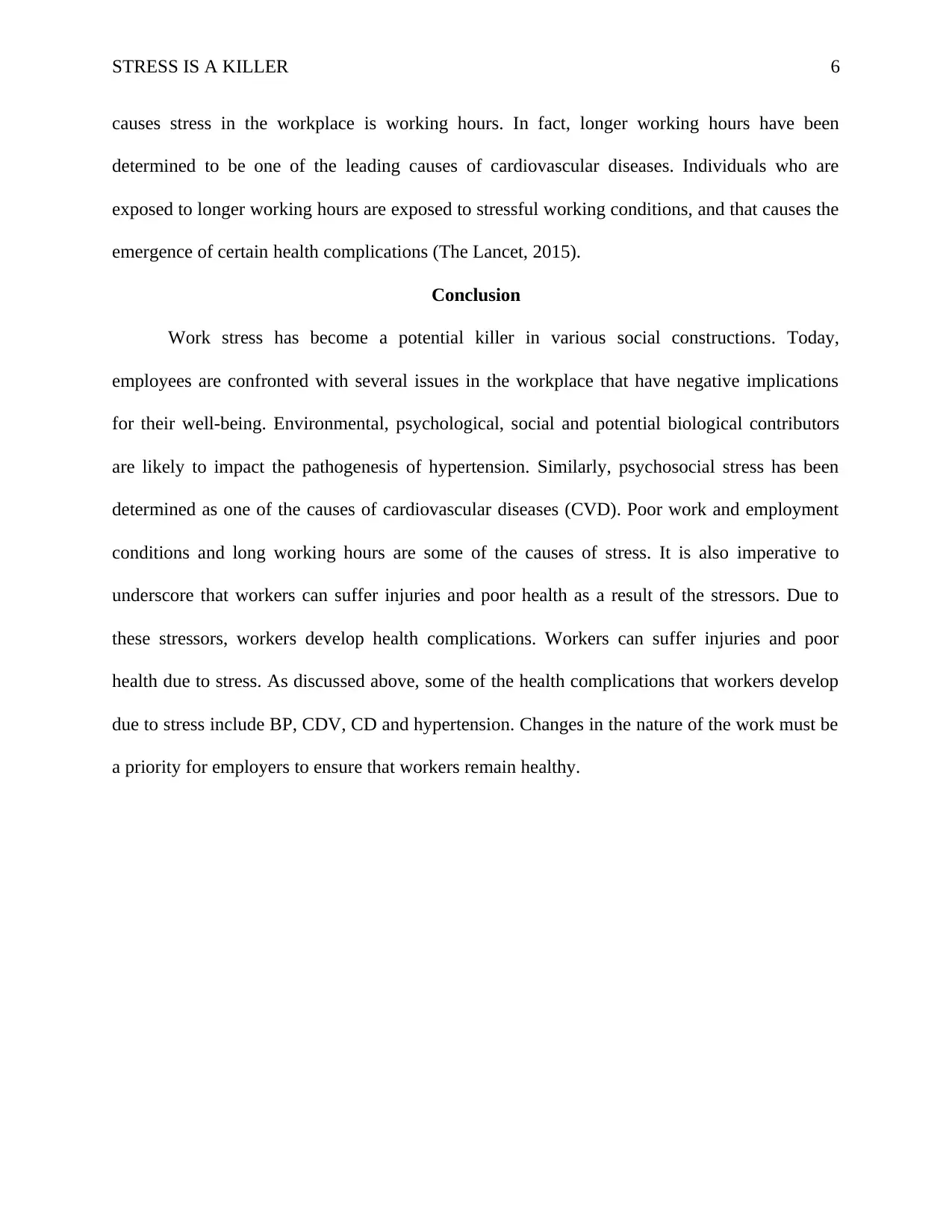
STRESS IS A KILLER 6
causes stress in the workplace is working hours. In fact, longer working hours have been
determined to be one of the leading causes of cardiovascular diseases. Individuals who are
exposed to longer working hours are exposed to stressful working conditions, and that causes the
emergence of certain health complications (The Lancet, 2015).
Conclusion
Work stress has become a potential killer in various social constructions. Today,
employees are confronted with several issues in the workplace that have negative implications
for their well-being. Environmental, psychological, social and potential biological contributors
are likely to impact the pathogenesis of hypertension. Similarly, psychosocial stress has been
determined as one of the causes of cardiovascular diseases (CVD). Poor work and employment
conditions and long working hours are some of the causes of stress. It is also imperative to
underscore that workers can suffer injuries and poor health as a result of the stressors. Due to
these stressors, workers develop health complications. Workers can suffer injuries and poor
health due to stress. As discussed above, some of the health complications that workers develop
due to stress include BP, CDV, CD and hypertension. Changes in the nature of the work must be
a priority for employers to ensure that workers remain healthy.
causes stress in the workplace is working hours. In fact, longer working hours have been
determined to be one of the leading causes of cardiovascular diseases. Individuals who are
exposed to longer working hours are exposed to stressful working conditions, and that causes the
emergence of certain health complications (The Lancet, 2015).
Conclusion
Work stress has become a potential killer in various social constructions. Today,
employees are confronted with several issues in the workplace that have negative implications
for their well-being. Environmental, psychological, social and potential biological contributors
are likely to impact the pathogenesis of hypertension. Similarly, psychosocial stress has been
determined as one of the causes of cardiovascular diseases (CVD). Poor work and employment
conditions and long working hours are some of the causes of stress. It is also imperative to
underscore that workers can suffer injuries and poor health as a result of the stressors. Due to
these stressors, workers develop health complications. Workers can suffer injuries and poor
health due to stress. As discussed above, some of the health complications that workers develop
due to stress include BP, CDV, CD and hypertension. Changes in the nature of the work must be
a priority for employers to ensure that workers remain healthy.

STRESS IS A KILLER 7
1 out of 7
Your All-in-One AI-Powered Toolkit for Academic Success.
+13062052269
info@desklib.com
Available 24*7 on WhatsApp / Email
![[object Object]](/_next/static/media/star-bottom.7253800d.svg)
Unlock your academic potential
© 2024 | Zucol Services PVT LTD | All rights reserved.
